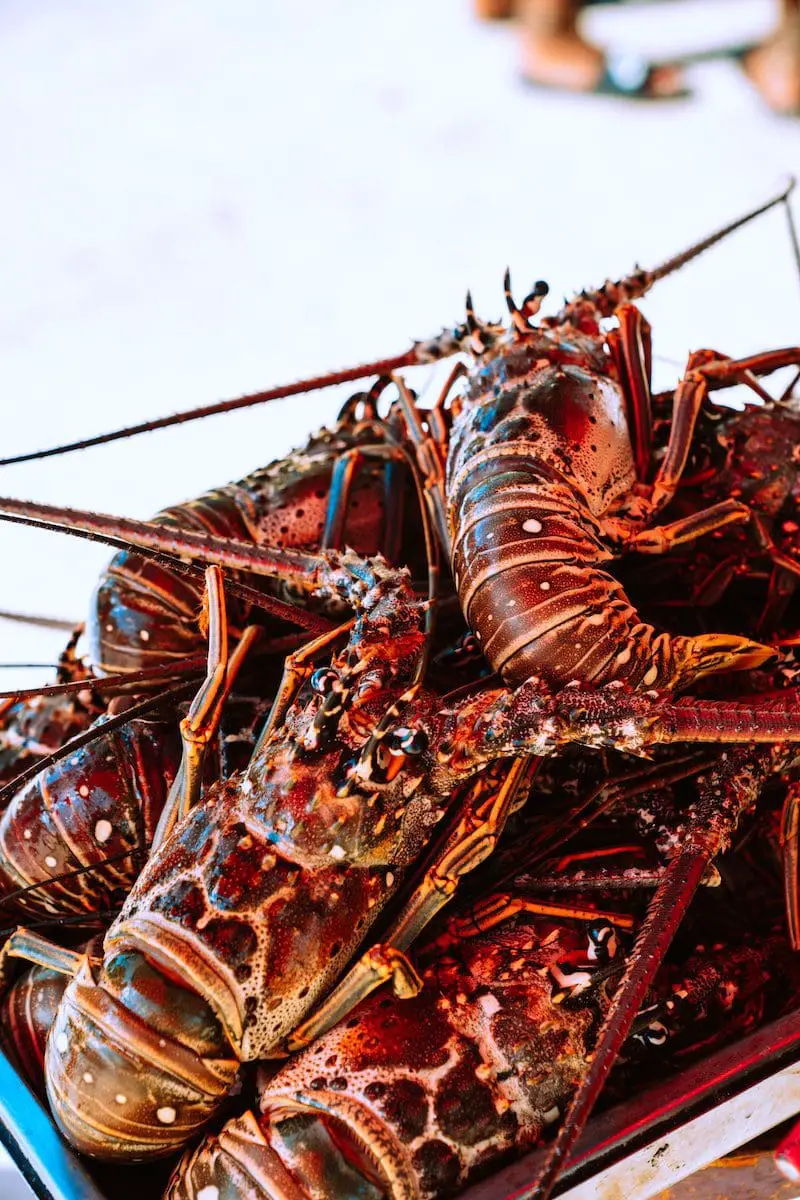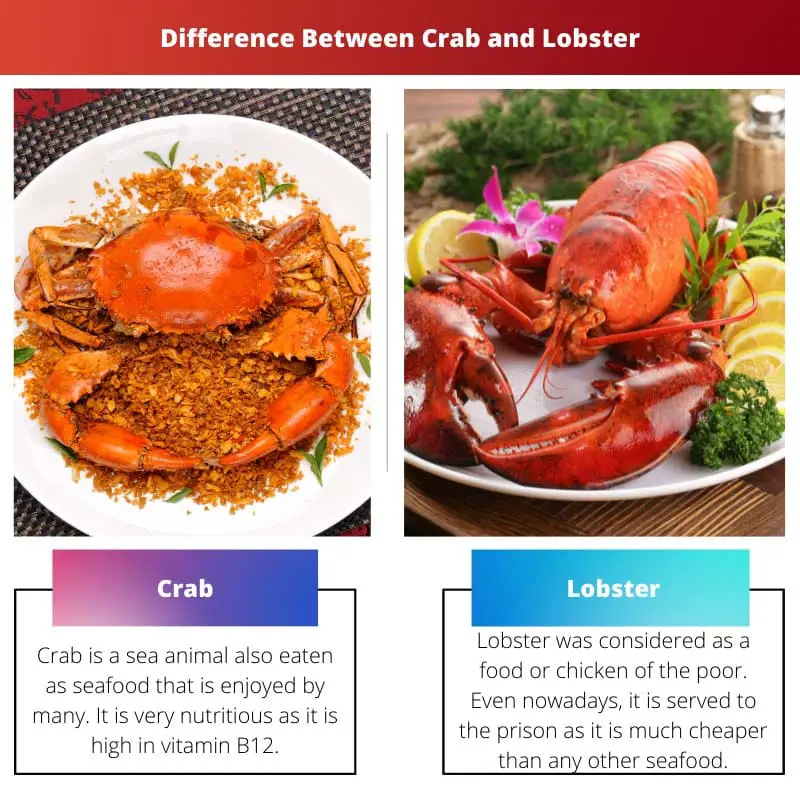People around the world enjoy seafood a lot. Each type of seafood has a different taste and texture. They are rich in nutrients, boost the brain, well for the heart, eases joint pain, increase and maintain good eyesight, gives flawless skin, etc., and all these are the reason behind their popularity.
Fish is the most commonly eaten seafood; every third person has eaten fish at least once in his lifetime.
While fish is common, some other kinds of seafood are enjoyed and liked by many. For Example, Crab and Lobster are similar to each other in many ways, but as the name suggests, they are not the same.
Key Takeaways
- Crabs have shorter, wider bodies; lobsters possess longer, narrower bodies with large tails.
- Crabs move sideways; lobsters move forward and backward.
- Crabs have two large, powerful front claws; lobsters have one claw for crushing and one for cutting.
Crab vs Lobster
A crab is a decapod crustacean with a flat round body covered by a shell. It has five pairs of legs with large claws on the front pair. A lobster is a large crustacean that has a longer, narrower body with massive claws in the front. It can also come in many sizes and colors but have a very distinct shape.

The crab has a large body with a short tail, antennae, and claws. They come in different shapes and sizes. There are two types of crabs, true crabs and false crabs.
They like to socialize very frequently and are thus known as social creatures that live a lifespan of 4-5 years, but the largest crab can even live up to 100 years.
Lobster is a family member of marine crustaceans. Their body structure is relatively smaller except for their tail, antennae, and claws, which are larger. They don’t live in a group and does not like socialising, and are a solitary creature.
They live a long life of around 100 years and change their color from green or blue into red when cooked.
Comparison Table
| Parameters of Comparison | Crab | Lobster |
|---|---|---|
| Size | Smaller in size | Larger in size |
| Claws | Are smaller | Are larger |
| Number of species | 6800 species | 85 species |
| Walk | Usually sideways | Walk forwards and backward |
| Tails | Short tails | Longer tails |
What is Crab?
Crab is a sea animal also eaten as seafood that is enjoyed by many. It is very nutritious as it is high in vitamin B12. There are around 6800 species of Crabs. The largest crab, which measures around 12 to 15 feet, is known as the Japanese Crab, and the smallest is the pea crab.
Crabs have ten (10) legs, large compound eyes, a hard shell that covers their body and a narrow body. Normally they live up to 4 years, but some crabs can even live for 100 years. They are omnivores which means they eat both meat and plant.
Some crabs live in the sea only, even in the ocean, and some particularly live on land. And gender of them can easily be found by looking at their abdomen. And the female crab can even lay around 100 eggs at once. Crabs use their claws and pincers for communication.
The cast is a term used to describe a group of crabs. There are some false crabs (crabs from Anomura) also, such as Hermit and King Crabs etc. Earlier, it was said that they do not suffer pain, but recent research suggests the opposite t said they also remember their pain.

What is Lobster?
Earlier, lobster was considered a food or chicken for the poor. Even nowadays, it is served to the prison as it is much cheaper than any other seafood. Naturally, they are not red but only turned when they are cooked.
Female lobsters carry the sperm in them and only fertilize their eggs when she wants, and they can only do that after she has molted. And they carry their eggs till they are hatched. Their eggs are known as Roe.
They can also turn into cannibals and eat smaller lobsters in times of crisis. They can grow to 4 feet and lives up to 100 years of life. They can be eaten in several ways. And are a great source of protein.
If the shell of a lobster is soft, it is considered to be sweet and tender in taste, which is also known as shedders, and is caught mostly from July till October.
Their vision is not good, but other senses, such as smell and taste, are enhanced. There is a limit only that you can hunt lobsters in a day, but they can also be grown on farms. Their blood is not red but white.
Last but not least, before the 90s, they were caught by hand only, but after that, the trapping method came into existence.

Main Differences Between Crab and Lobster
- When the sizes of both animals are compared, a lobster has a smaller body than a crab which can have a body up to even 12 feet, while most lobster grows to 5 feet.
- They also have different body structures, such as the eyes of a crab on their eyestalks and the eyes of a lobster on the base of the antennae. Along with this, crabs have a large carapace covering their body and exoskeleton, which is small in size, whereas lobster has a comparatively larger and longer exoskeleton.
- Although crabs have larger bodies, their claws are much smaller in size than lobsters. Despite their small body, their claws are larger when compared. Not only this, but crabs also have short tails and antennae as compared to lobsters.
- Crabs have more species, about 6800 in number, while lobster has species of around 85 in number.
- Crabs can walk normally forward and backward, but mostly they walk sideways, while lobsters always walk forward and backward only.
- Crabs are more social than lobsters which live in solitary.
- Generally, lobsters live a longer life than a normal crab, but there are some exceptions too.

- https://www.jstor.org/stable/20104952
- https://cdnsciencepub.com/doi/abs/10.1139/f58-073
- https://pubmed.ncbi.nlm.nih.gov/25144082/
- https://books.google.com/books?hl=en&lr=&id=FBLTDwAAQBAJ&oi=fnd&pg=PA17&dq=what+is+seafood&ots=zVFdlz9i5i&sig=4WSzCzczSo1DBlfCP3tVzTMxhDw
- https://www.sciencedirect.com/science/article/pii/S0308814613000575

The dietary benefits of crabs and lobsters, particularly the high Vitamin B12 content in crabs, are significant for human nutrition.
In addition to their nutritional value, the ecological roles of crabs and lobsters in marine ecosystems are worth exploring.
Certainly, these seafood options provide essential nutrients that contribute to overall health and wellness.
The comparison between crab and lobster species highlights the diverse characteristics and ecological niches occupied by these fascinating creatures.
Certainly, examining the biological diversity within these species enriches our understanding of marine biodiversity.
Crab and lobster are both rich sources of protein and can be enjoyed in numerous culinary dishes.
Their long lifespans and unique behaviors also make them intriguing to study and learn about.
Absolutely, the versatility of these seafood options allows for a wide array of flavors and textures.
The differences in movement, body structure, and behaviors between crabs and lobsters showcase the diversity and complexity of marine life.
Exploring the biological features of crabs and lobsters sheds light on the evolutionary mechanisms that have shaped their remarkable traits.
Absolutely, these distinctions reflect the incredible range of adaptations that have evolved in marine organisms.
Concerning the sustainability and conservation of these sea creatures, it’s important to recognize the impact of fishing practices on crab and lobster populations.
Absolutely, the balance between human consumption and conservation efforts is crucial for the preservation of these species.
Environmental awareness plays a key role in safeguarding the natural habitats of crabs and lobsters.
Learning about the distinctive features and ecological importance of crabs and lobsters fosters a deeper appreciation for the complex dynamics of marine ecosystems.
Absolutely, studying these fascinating creatures enriches our understanding of marine life and the interconnectedness of ecological processes.
The fact that lobsters can live up to 100 years is truly fascinating and showcases the resilience of these marine creatures.
Agreed, it’s remarkable how these animals can thrive for such an extended period of time.
The ability of lobsters to change color based on whether they’re cooked or not is a peculiar feature.
The unique social behaviors of crabs and the solitary nature of lobsters provide fascinating insights into their interactions within marine environments.
Indeed, understanding the social dynamics and ecological adaptations of these animals contributes to our appreciation of marine ecosystems.
Both crabs and lobsters exhibit unique evolutionary adaptations and life history traits that contribute to the remarkable success of these marine organisms.
Exploring the genetic and morphological diversity within crab and lobster species provides valuable insights into marine ecology and evolution.
Indeed, their evolutionary strategies and physiological capabilities are fascinating subjects for scientific inquiry.
Both crabs and lobsters have unique characteristics and habits that make them interesting sea creatures.
Yes, crabs and lobsters have a wide variety of colors and sizes that make them interesting.
I agree, and their nutritional value as seafood adds to their importance.